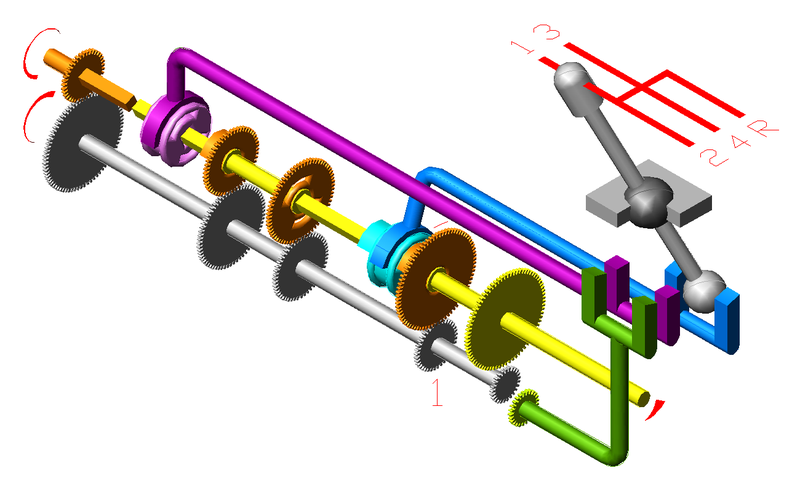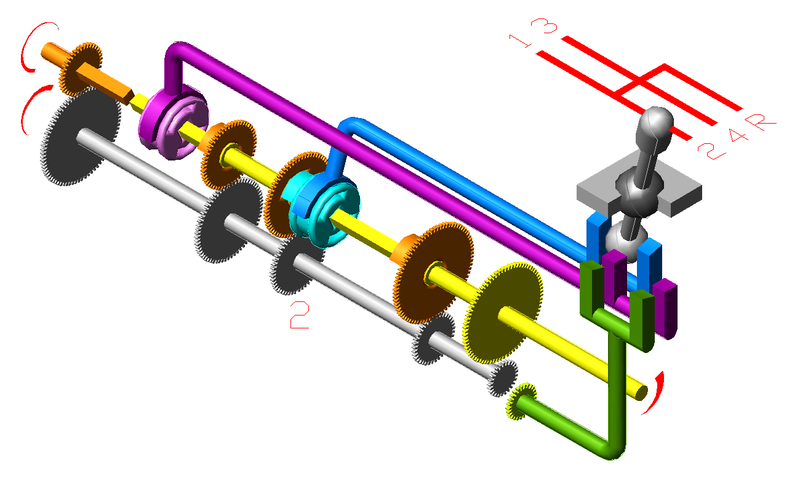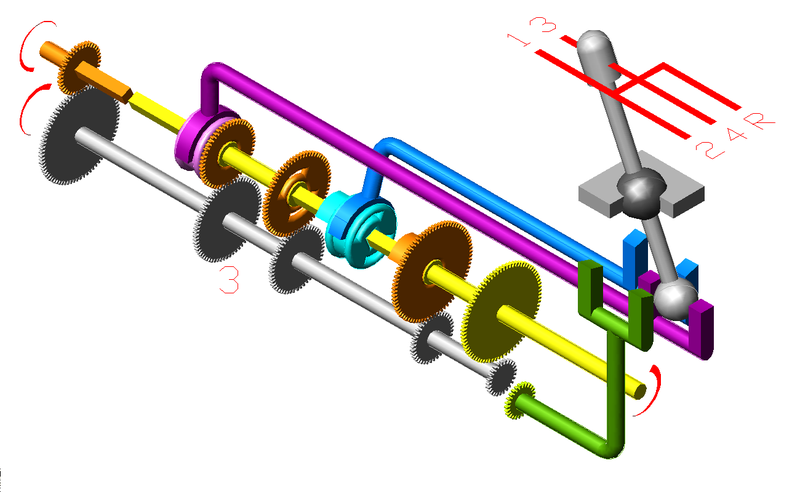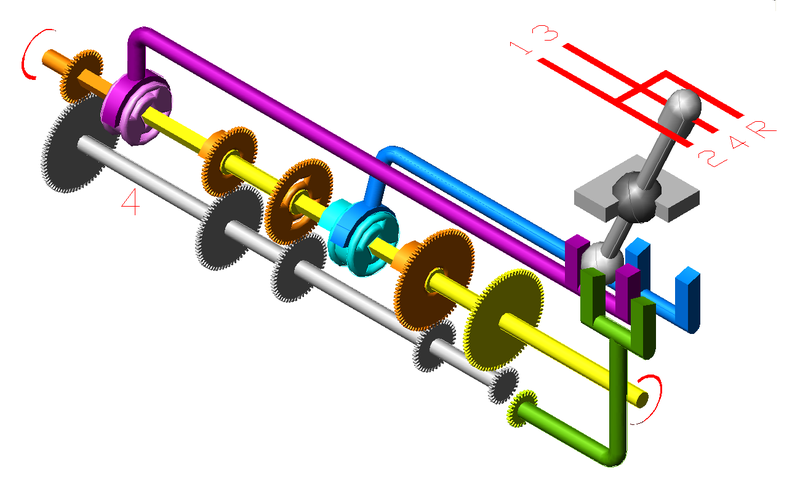A Real Transmission
The following animation shows you the internal workings of a four-speed transmission with reverse.
Animation courtesy Geebee's Vector Animations









Animation courtesy Geebee's Vector Animations

The five-speed manual transmission is fairly standard on cars today. Internally, it looks something like this:
 |
There are three forks controlled by three rods that are engaged by the shift lever. Looking at the shift rods from the top, they look like this in reverse, first and second gear:
 |





Keep in mind that the shift lever has a rotation point in the middle. When you push the knob forward to engage first gear, you are actually pulling the rod and fork for first gear back.
You can see that as you move the shifter left and right you are engaging different forks (and therefore different collars). Moving the knob forward and backward moves the collar to engage one of the gears.
 |
Reverse gear is handled by a small idler gear (purple). At all times, the blue reverse gear in this diagram is turning in a direction opposite to all of the other blue gears. Therefore, it would be impossible to throw the transmission into reverse while the car is moving forward -- the dog teeth would never engage. However, they will make a lot of noise!
Synchronizers
Manual transmissions in modern passenger cars use synchronizers to eliminate the need for double-clutching. A synchro's purpose is to allow the collar and the gear to make frictional contact before the dog teeth make contact. This lets the collar and the gear synchronize their speeds before the teeth need to engage, like this:
Manual transmissions in modern passenger cars use synchronizers to eliminate the need for double-clutching. A synchro's purpose is to allow the collar and the gear to make frictional contact before the dog teeth make contact. This lets the collar and the gear synchronize their speeds before the teeth need to engage, like this:
 |
The cone on the blue gear fits into the cone-shaped area in the collar, and friction between the cone and the collar synchronize the collar and the gear. The outer portion of the collar then slides so that the dog teeth can engage the gear.
Every manufacturer implements transmissions and synchros in different ways, but this is the general idea.
Continuously Variable Transmissions

A CVT has a nearly infinite range of gear ratios. In the past, CVTs could not compete with four-speed and five-speed transmissions in terms of cost, size and reliability, so you didn't see them in production automobiles. These days, improvements in design have made CVTs more common. The Toyota Prius is a hybrid car that uses a CVT.
The transmission is connected to the engine through the clutch. The input shaft of the transmission therefore turns at the same rpm as the engine.
 Photo courtesy DaimlerChrysler Mercedes-Benz C-class sport coupe, six-speed manual transmission, graphic illustration. |
|
A five-speed transmission applies one of five different gear ratios to the input shaft to produce a different rpm value at the output shaft. Here are some typical gear ratios:
A Very Simple Transmission

To understand the basic idea behind a standard transmission, the diagram below shows a very simple two-speed transmission in neutral:
Let's look at each of the parts in this diagram to understand how they fit together:
- The green shaft comes from the engine through the clutch. The green shaft and green gear are connected as a single unit. (The clutch is a device that lets you connect and disconnect the engine and the transmission. When you push in the clutch pedal, the engine and the transmission are disconnected so the engine can run even if the car is standing still. When you release the clutch pedal, the engine and the green shaft are directly connected to one another. The green shaft and gear turn at the same rpm as the engine.)
- The red shaft and gears are called the layshaft. These are also connected as a single piece, so all of the gearson the layshaft and the layshaft itself spin as one unit. The green shaft and the red shaft are directly connected through their meshed gears so that if the green shaft is spinning, so is the red shaft. In this way, the layshaft receives its power directly from the engine whenever the clutch is engaged.
- The yellow shaft is a splined shaft that connects directly to the drive shaft through the differential to the drive wheels of the car. If the wheels are spinning, the yellow shaft is spinning.
- The blue gears ride on bearings, so they spin on the yellow shaft. If the engine is off but the car is coasting, the yellow shaft can turn inside the blue gears while the blue gears and the layshaft are motionless.
- The purpose of the collar is to connect one of the two blue gears to the yellow drive shaft. The collar is connected, through the splines, directly to the yellow shaft and spins with the yellow shaft. However, the collar can slide left or right along the yellow shaft to engage either of the blue gears. Teeth on the collar, called dog teeth, fit into holes on the sides of the blue gears to engage them.
Now, let's see what happens when you shift into first gear.
First Gear
The picture below shows how, when shifted into first gear, the collar engages the blue gear on the right:

In this picture, the green shaft from the engine turns the layshaft, which turns the blue gear on the right. This gear transmits its energy through the collar to drive the yellow drive shaft. Meanwhile, the blue gear on the left is turning, but it is freewheeling on its bearing so it has no effect on the yellow shaft.
When the collar is between the two gears (as shown in the first figure), the transmission is in neutral. Both of the blue gears freewheel on the yellow shaft at the different rates controlled by their ratios to the layshaft.
From this discussion, you can answer several questions:
- When you make a mistake while shifting and hear a horrible grinding sound, you are not hearing the sound of gear teeth mis-meshing. As you can see in these diagrams, all gear teeth are all fully meshed at all times. The grinding is the sound of the dog teeth trying unsuccessfully to engage the holes in the side of a blue gear.
- The transmission shown here does not have "synchros" (discussed later in the article), so if you were using this transmission you would have to double-clutch it. Double-clutching was common in older cars and is still common in some modern race cars. In double-clutching, you first push the clutch pedal in once to disengage the engine from the transmission. This takes the pressure off the dog teeth so you can move the collar into neutral. Then you release the clutch pedal and rev the engine to the "right speed." The right speed is the rpm value at which the engine should be running in the next gear. The idea is to get the blue gear of the next gear and the collar rotating at the same speed so that the dog teeth can engage. Then you push the clutch pedal in again and lock the collar into the new gear. At every gear change you have to press and release the clutch twice, hence the name "double-clutching."
- You can also see how a small linear motion in the gear shift knob allows you to change gears. The gear shift knob moves a rod connected to the fork. The fork slides the collar on the yellow shaft to engage one of two gears.
In the next section, we'll take a look at a real transmission.
A Real Transmission
The following animation shows you the internal workings of a four-speed transmission with reverse.
Animation courtesy Geebee's Vector Animations
Animation courtesy Geebee's Vector Animations
The five-speed manual transmission is fairly standard on cars today. Internally, it looks something like this:
 |
There are three forks controlled by three rods that are engaged by the shift lever. Looking at the shift rods from the top, they look like this in reverse, first and second gear:
 |
Keep in mind that the shift lever has a rotation point in the middle. When you push the knob forward to engage first gear, you are actually pulling the rod and fork for first gear back.
You can see that as you move the shifter left and right you are engaging different forks (and therefore different collars). Moving the knob forward and backward moves the collar to engage one of the gears.
 |
Reverse gear is handled by a small idler gear (purple). At all times, the blue reverse gear in this diagram is turning in a direction opposite to all of the other blue gears. Therefore, it would be impossible to throw the transmission into reverse while the car is moving forward -- the dog teeth would never engage. However, they will make a lot of noise!
Synchronizers
Manual transmissions in modern passenger cars use synchronizers to eliminate the need for double-clutching. A synchro's purpose is to allow the collar and the gear to make frictional contact before the dog teeth make contact. This lets the collar and the gear synchronize their speeds before the teeth need to engage, like this:
Manual transmissions in modern passenger cars use synchronizers to eliminate the need for double-clutching. A synchro's purpose is to allow the collar and the gear to make frictional contact before the dog teeth make contact. This lets the collar and the gear synchronize their speeds before the teeth need to engage, like this:
 |
The cone on the blue gear fits into the cone-shaped area in the collar, and friction between the cone and the collar synchronize the collar and the gear. The outer portion of the collar then slides so that the dog teeth can engage the gear.
Every manufacturer implements transmissions and synchros in different ways, but this is the general idea.
For more information on transmissions and related topics, check out the links on the next page.
Thanks to :
Wikipedia